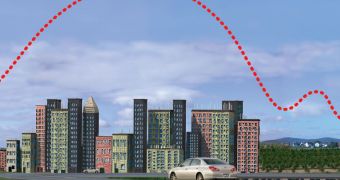Large metropolises such as New York, Tokyo and London share various traits in common, not the last of which being the fact that they are considerably warmer than their surroundings. This is largely due to the “heat island” effect, researchers say.
Various factors, including city size, background ecology, and development patterns combine to cause the effect, which promotes warming in the metropolises, compared to the areas adjacent to them.
A team of scientists at the American space agency presented new findings on the issue at the 2010 annual fall meeting of the American Geophysical Union (AGU), held in San Francisco, California.
Experts conducted the investigation for three years, and determined that land surface temperatures in cities in the American Northeast (NYC, Boston, Philadelphia) boasted consistently higher average levels that surrounding rural areas.
Temperature differences can apparently exceed the norm by 7 to 9 degrees Celsius (13 to 16 degree Fahrenheit), the study revealed. The urban heat island effect is heavily at work here, researchers say.
This effect is not new, as weather analysts have observed it for the first time more than two centuries ago. What changed was the amount of extra heat cities experienced as opposed to surrounding regions.
The new research “at least to our knowledge, is the first time that anybody has systematically compared the heat islands of a large number of cities at continental and global scales,” explains Ping Zhang.
The researcher holds an appointment as a scientist at the NASA Goddard Space Flight Center (GSFC), in Greenbelt, Maryland, and is also the lead author of the new research.
“The urban heat island is a relative measure comparing the temperature of the urban core to the surrounding area. As a result, the condition of the rural land around the city matters a great deal,” adds the GSFC group leader, Marc Imhoff.
Among the reasons the effect develops, researchers included the replacing of vegetation such as forests and bushes with pavement and related infrastructure. This has great influences on the way plants act.
Plant transpiration, the evaporative process that helps cool plant leaves and also air temperatures around, is severely limited, which gives ample room for heat to gather and concentrate.
Motor vehicles, factories, and homes also contribute to the overall warming of the cities. “There's no one solution, and it's going to be different for every city. Heat islands are complex phenomena,” says University of Hawaii expert Benedicte Dousset.
Satellite instruments such as the Moderate-resolution Imaging Spectroradiometer (MODIS)aboard the NASA Aqua and Terra spacecraft, were used to collect temperature data.

 14 DAY TRIAL //
14 DAY TRIAL //